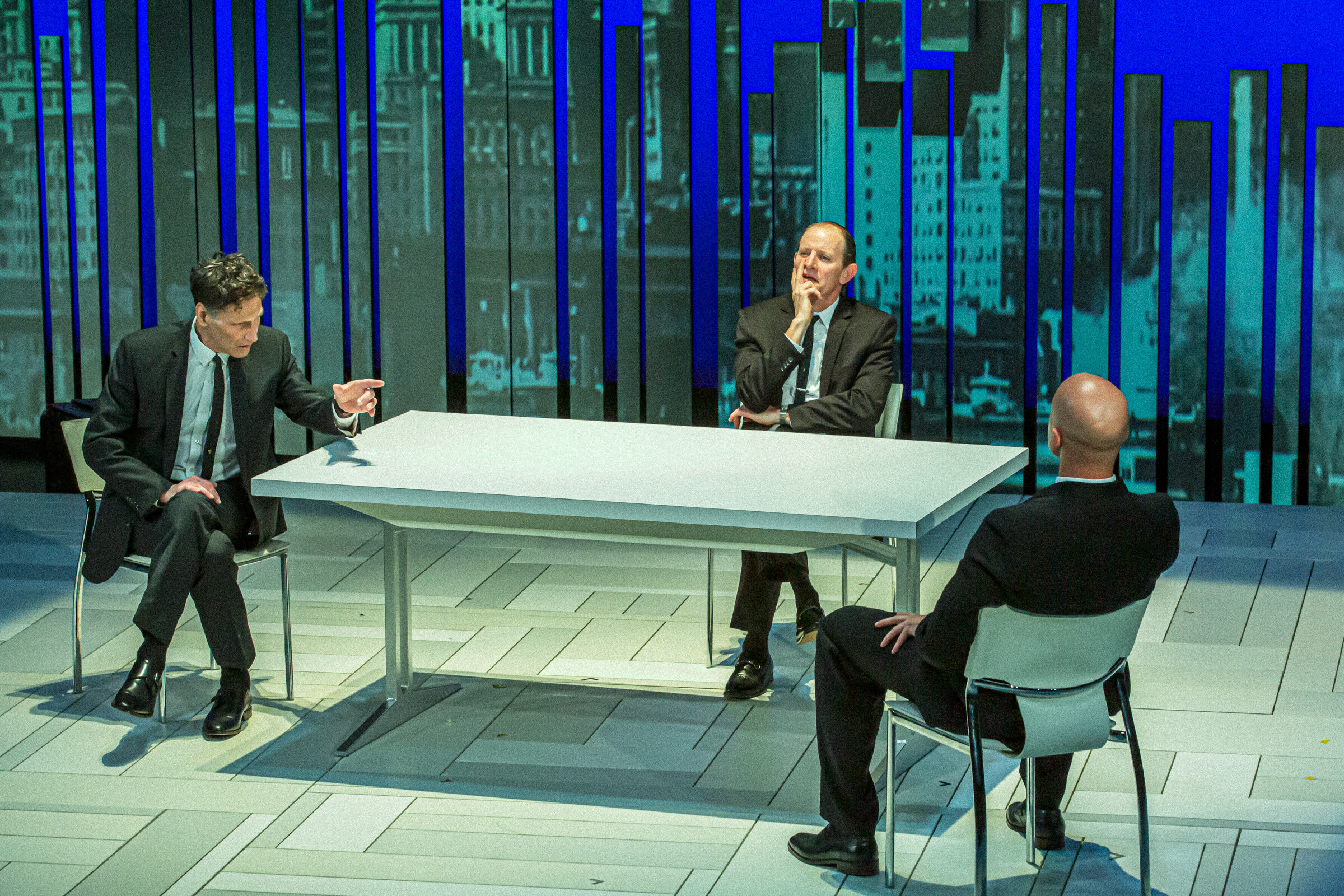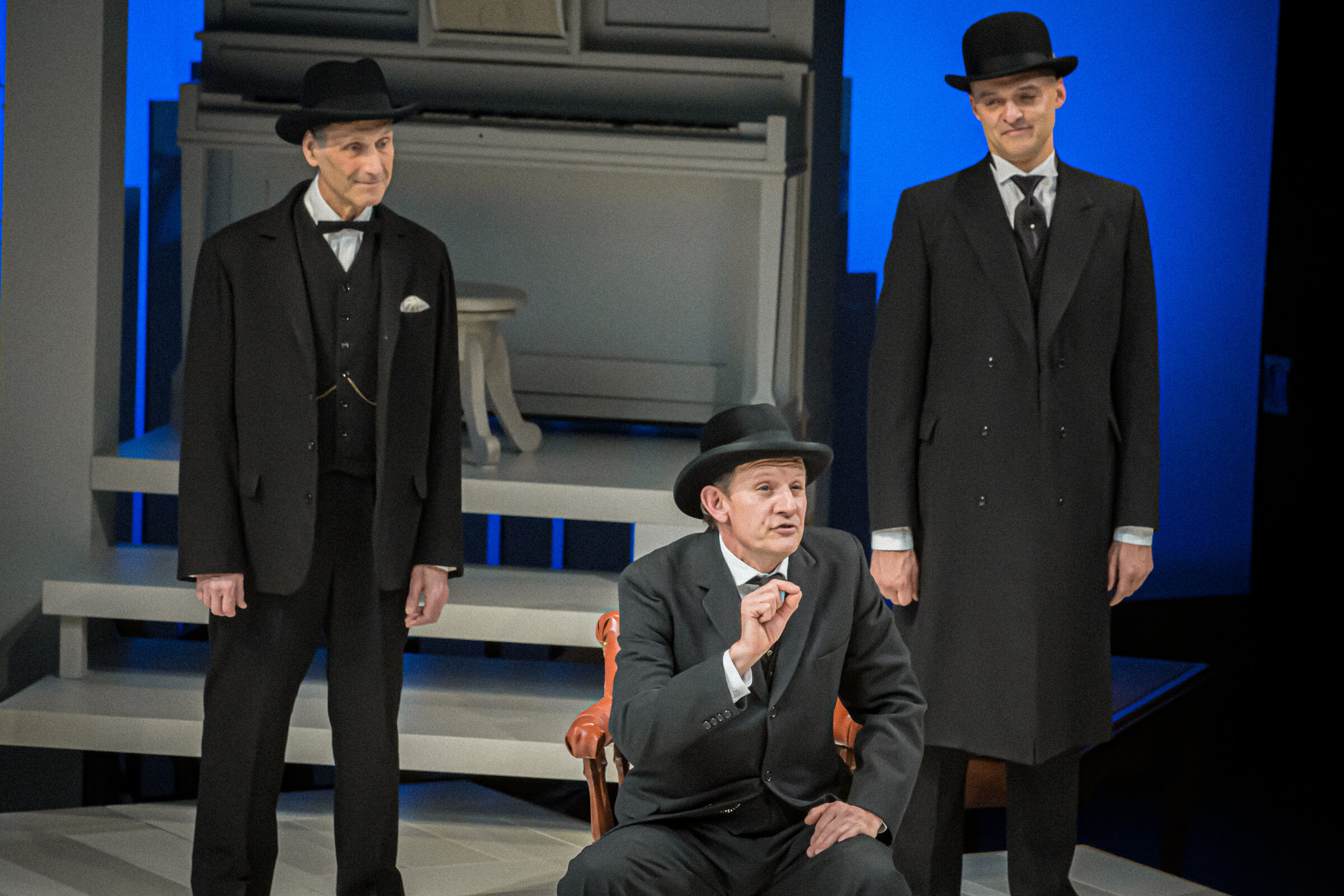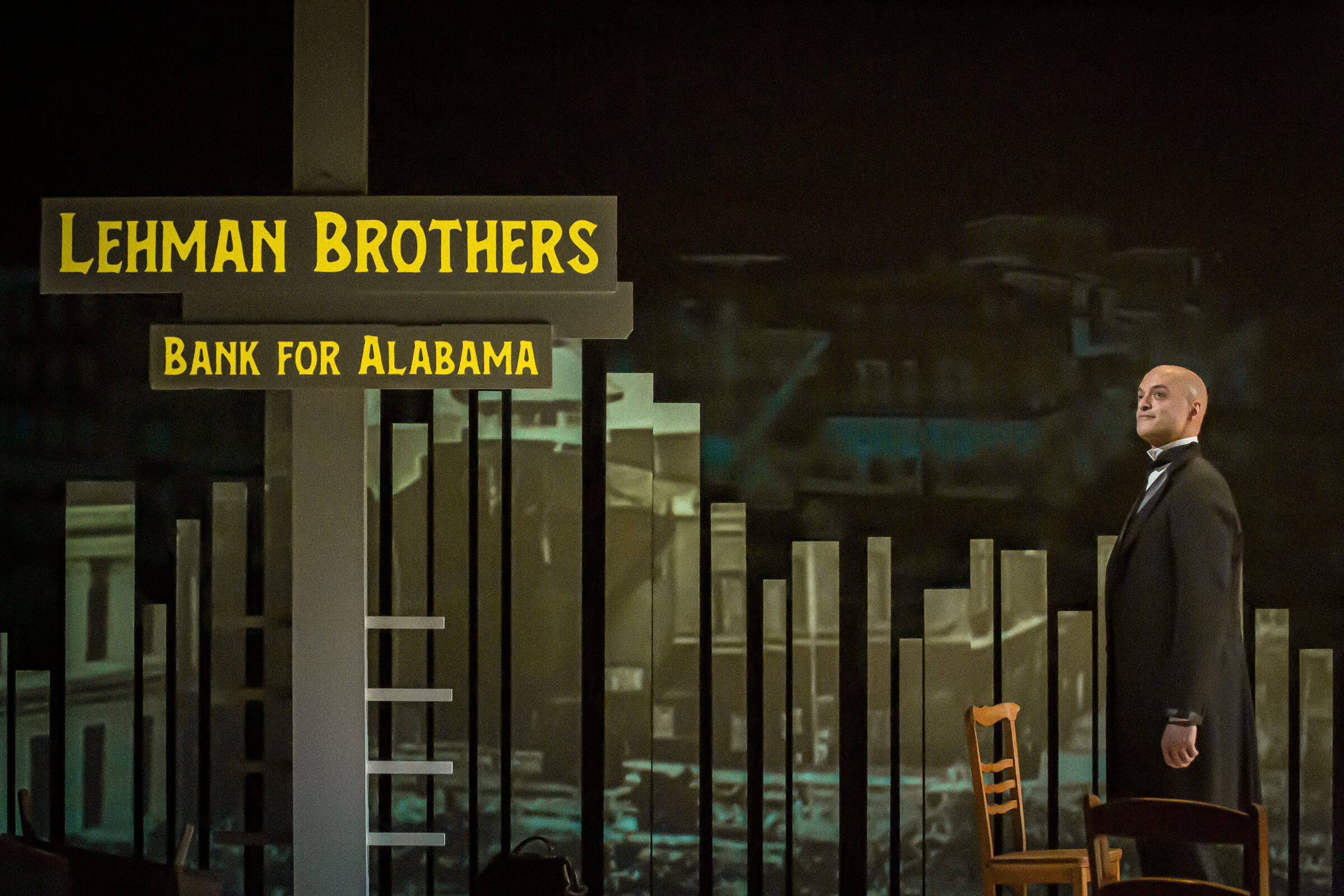“In one minute, a phone will ring and it will all be gone:” The Rise and Fall of the Lehmans in Theater
Review of THE LEHMAN TRILOGY at ACT THEATRE
Written by TeenTix Newsroom Writer SYLVIA JARMAN and edited by Teen Editorial Staff Member AUDREY GRAY

It’s difficult to imagine the humanity behind a faceless entity like a corporation. With the way that many corporations are discussed in the news and media, it becomes a challenge to remember that there are people behind them and that at a certain point, the business ceases to represent them. This loss of connection and humanity was observed by Stefano Massini and captured in his play The Lehman Trilogy, a show of epic proportions that depicts the inner lives of the family behind Lehman Brothers Bank, a company widely known in part because of its eventual downfall. Ben Powers’ adaptation of the script was brought to life on stage by director John Langs and a mere trio of actors: ACT’s adaptation of The Lehman Trilogy presents an incredibly emotional, engaging elaboration on the play through the clever staging and direction, evocative performances, and impressive technical prowess. These aspects of the adaptation offer a remarkable portrayal of the Lehman family’s journey to America, their business’s rise to prominence, the painstaking power struggles against one another, and the cycle of fathers, sons, and brothers that brought the business into existence.
The play follows three generations of the Lehman family and the evolution of the family business across those generations, from humble beginnings of a fabric store in Alabama to an internationally renowned, immensely powerful investment bank. An act is dedicated to each era of the family, spanning from the 1840s to the 2000s, and with each era, a different iteration of the Lehman Brothers’ business. The first act sees the business grow in scale as the brothers are pitted against each other, through the chaos of the Montgomery fire and the beginnings of the Civil War. The second act sees the turn of the century, with the business moved to New York City and reaching new heights under the control of the family’s next generation. The business grows and grows, but faces the looming threat of the market crash by the end of act two. Finally, the third act details the harrowing struggle of the final generation of Lehmans to pull America out of the Depression. Following their success, the show takes a turn, depicting the arrogant feeling of invincibility held by the workers at the Lehman Corporation as the business transitions to one of the biggest international investment banks. The energy of the third act enraptures the viewer, to the point where the foregone conclusion of bankruptcy still felt like a shocking ending, leaving the audience reeling as the stage blacks out.

The long runtime may seem intimidating, but the show’s pace is quick and precisely timed, feeling almost mechanical. There is a staggering amount of information bestowed upon the audience, but it never feels overwhelming. It’s a miracle, considering the density of the subject matter. Langs handled the behemoth of a script masterfully, managing to create an enthralling portrayal out of something so complicated. ACT’s adaptation truly animated Massini’s script, imbuing it with immense comedy whilst maintaining the understated tragedy central to the show. This sense of humor is vital to the show’s intrigue, making the drama and emotion more impactful through a profound sense of contrast. The heart wrenching moments hit harder when they are immediately preceded by something plainly comical. A surreal dance number in the third act accompanies a monologue detailing the seemingly unstoppable growth of the business and Bobby Lehman clinging to his youth. This is immediately followed by the revelation that Bobby is the last member of the Lehman family with a hand in the business, and once he dies, that connection is severed once and for all. The music suddenly stops at this revelation, the actors hold still, and the knife is twisted when the audience recalls the absurdity and comedy that immediately preceded this.
For such a small cast, there are an enormous number of roles, all demanding different speaking patterns, mannerisms, and depictions of interpersonal relationships. Yet the three actors—Robert Pescovitz, Bradford Farwell, and Brandon J. Simmons—handle the task with incredible tact and thorough attention to detail. They are able to embody such a wide variety of characters—from coquettish, lovestruck teenage girls to gruff, high-power businessmen—with such fluidity that I found myself forgetting that the cast consisted of only three people. The most impressive part of this is the precision and nuance with which they portrayed the relationships between the members of the Lehman family. The relationship between Henry and Mayer is a near polar opposite to that of Phillip and Bobby, one a willing partnership between brothers and the other a deeply bitter, resentful relationship between father and son—and yet, both are portrayed to perfection by Pescovitz and Simmons without any of these lines getting blurred.

While the acting and direction deserve proper commendations, what truly elevated the show was the astonishing sound and lighting design. Lehman makes an illustrative case for the impact of effective sound design, something overlooked and underutilized in many theater productions. From the shocking cannonfire as the Civil War breaks out to the soul-wrenching gunshots as the market crashes on Black Thursday, an already engaging performance becomes entirely immersive. This is also seen with the use of leitmotifs, a creative interpretation of the script and recurring symbol of music boxes. With a show so reliant on recurring elements and callbacks, the incorporation of leitmotifs was an incredibly clever choice that provides a lot of color to many scenes and makes many recurring moments like the dream sequences feel more emotionally resonant. The lighting also brought the production to a much higher level, with clever projections interspersed throughout the show, helping the audience get their bearings as the setting transitions and punctuating scenes with striking visuals, such as burning fields during the fire in Montgomery and rapidly falling stock prices during the Depression.

Even though I had gone into the show knowing the fate of the Lehman Brothers bank, I still felt blindsided when the sign fell, signifying the end of the business. I had just watched 200 years of growth condensed into 3 acts, only for it to inevitably come to nothing. What is integral to Langs’ interpretation of the show is the humanity behind it. The Lehmans are portrayed neither as paragons or villains, good or evil: they are shown merely as a family of deeply troubled men with arduous relationships with one another. The show expertly demystifies one of the most prominent families in modern history, which is exactly why it’s shocking to see the bank fail. These were no longer faceless names attached to a bank that was long gone before I knew of it—this was merely a family who had found their way to America and made something with what they could.
Lehman was an incredible accomplishment for ACT Theater. It was a showcase of the many brilliant talents associated with ACT, and a wonderful, emotional send-off for John Langs, as his final show serving as ACT’s Artistic Director. The amount of work and careful thought that went into every aspect of Lehman managed to take a 3-hour goliath of a play on an impossibly dense subject and transform it into an immersive experience with impeccable directing and palpably emotional performances, finding the sense of humanity and connection that was lost as the Lehman brothers business grew.
Lead Photo Credit: The Lehman Trilogy at ACT Contemporary Theatre, photo by Rosemary Dai Ross
The TeenTix Newsroom is a group of teen writers led by the Teen Editorial Staff. For each review, Newsroom writers work individually with a teen editor to polish their writing for publication. The Teen Editorial Staff is made up of 5 teens who curate the review portion of the TeenTix blog. More information about the Teen Editorial Staff can be found HERE.
The TeenTix Press Corps promotes critical thinking, communication, and information literacy through criticism and journalism practice for teens. For more information about the Press Corps program see HERE.

